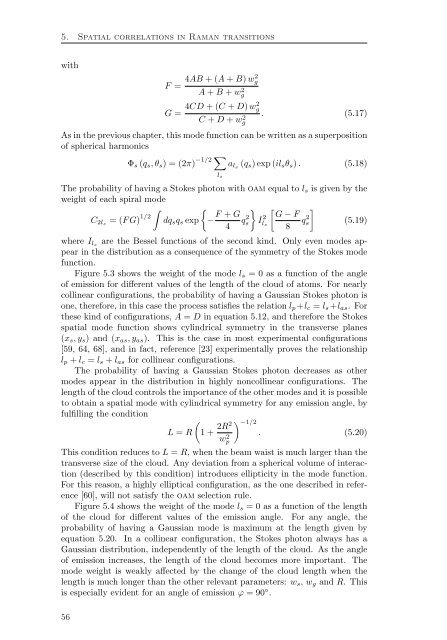Spatial Characterization Of Two-Photon States - GAP-Optique
Spatial Characterization Of Two-Photon States - GAP-Optique
Spatial Characterization Of Two-Photon States - GAP-Optique
You also want an ePaper? Increase the reach of your titles
YUMPU automatically turns print PDFs into web optimized ePapers that Google loves.
5. <strong>Spatial</strong> correlations in Raman transitions<br />
with<br />
F = 4AB + (A + B) w2 g<br />
A + B + w 2 g<br />
G = 4CD + (C + D) w2 g<br />
C + D + w2 . (5.17)<br />
g<br />
As in the previous chapter, this mode function can be written as a superposition<br />
of spherical harmonics<br />
Φs (qs, θs) = (2π)<br />
−1/2 <br />
ls<br />
als (qs) exp (ilsθs) . (5.18)<br />
The probability of having a Stokes photon with oam equal to ls is given by the<br />
weight of each spiral mode<br />
<br />
F + G<br />
C2ls = (F G)1/2 dqsqs exp − q<br />
4<br />
2 <br />
s I 2 <br />
G − F<br />
ls q<br />
8<br />
2 <br />
s (5.19)<br />
where Ils are the Bessel functions of the second kind. Only even modes appear<br />
in the distribution as a consequence of the symmetry of the Stokes mode<br />
function.<br />
Figure 5.3 shows the weight of the mode ls = 0 as a function of the angle<br />
of emission for different values of the length of the cloud of atoms. For nearly<br />
collinear configurations, the probability of having a Gaussian Stokes photon is<br />
one, therefore, in this case the process satisfies the relation lp+lc = ls +las. For<br />
these kind of configurations, A = D in equation 5.12, and therefore the Stokes<br />
spatial mode function shows cylindrical symmetry in the transverse planes<br />
(xs, ys) and (xas, yas). This is the case in most experimental configurations<br />
[59, 64, 68], and in fact, reference [23] experimentally proves the relationship<br />
lp + lc = ls + las for collinear configurations.<br />
The probability of having a Gaussian Stokes photon decreases as other<br />
modes appear in the distribution in highly noncollinear configurations. The<br />
length of the cloud controls the importance of the other modes and it is possible<br />
to obtain a spatial mode with cylindrical symmetry for any emission angle, by<br />
fulfilling the condition<br />
<br />
L = R 1 + 2R2<br />
w2 −1/2<br />
. (5.20)<br />
p<br />
This condition reduces to L = R, when the beam waist is much larger than the<br />
transverse size of the cloud. Any deviation from a spherical volume of interaction<br />
(described by this condition) introduces ellipticity in the mode function.<br />
For this reason, a highly elliptical configuration, as the one described in reference<br />
[60], will not satisfy the oam selection rule.<br />
Figure 5.4 shows the weight of the mode ls = 0 as a function of the length<br />
of the cloud for different values of the emission angle. For any angle, the<br />
probability of having a Gaussian mode is maximum at the length given by<br />
equation 5.20. In a collinear configuration, the Stokes photon always has a<br />
Gaussian distribution, independently of the length of the cloud. As the angle<br />
of emission increases, the length of the cloud becomes more important. The<br />
mode weight is weakly affected by the change of the cloud length when the<br />
length is much longer than the other relevant parameters: ws, wg and R. This<br />
is especially evident for an angle of emission ϕ = 90◦ .<br />
56



